Patagonia Lake Fishing Report

Patagonia Lake is a small reservoir lake that sits 186 miles away from Phoenix, Arizona and 73 miles from Tucson, Arizona
Overall it’s a quiet lake being nestled in part of the lower part of Arizona. In this post you’re going to be given the blueprint to fish this lake.
So what are the best tips for fishing Patagonia Lake? There are three important factors you must know if you want to know how to fish Patagonia Lake successfully. First, you need to know what kind of fish is in Patagonia Lake. Second, it’s important for you to know which part of the lake each species can be found. Lastly, knowing what are the best baits that work on Patagonia Lake is vital. However, tactics, baits, and locations will be different for each type of fish that you target. So let’s talk about the steps you need to take in order to give you the best chance of catching a fish on Patagonia Lake.
WARNING: There’s a lot of information about this subject you’ll probably want to come back to. No one expects you to remember all these tips. We know your time is precious, so we really tried to over-deliver in value for you. Additionally, we frequently update reports like this, so you’ll want to stay up to date with any changes or additional tips we include for you.
We found that the easiest way to save and bookmark this report so you can come back to it later is to share it on your favorite social media platform, especially if you use your phone to get important tips like the ones in this report here…
Click on your favorite social media buttons to remember this page now!
About Patagonia Lake
Patagonia Lake is a deep body of water with the average depth being 75 feet and a maximum depth of 120 feet when the lake is completely full. It spans 265 acres and is fed by the Sonoita Creek.
Because of its location large quantities of bass, catfish, crappie, and bluegill are found in Patagonia Lake. During the winter months, you can catch rainbow trout (Rainbow trout are supplied every two-three weeks from October to March) and it’s an outstanding area to fish from the shore or from a boat.
There are fishing tournaments held on this lake, however not as many as you would encounter as some of the other larger lakes in Arizona.
Important Lake Warnings
Algae blooms may be present which may affect fishing, swimming, and water contact in general.
If you are fishing and camping, fire bans may be in effect due to the ongoing drought conditions.
There is no maximum horsepower restriction on this lake.
What Kind Of Fish Is In Patagonia Lake?
- Rainbow Trout
- Largemouth Bass
- Black Crappie
- Bluegill and Sunfish
- Catfish
Patagonia Lake Fishing Tips & General Fishing Strategies

It can be a challenge to break down Patagonia Lake and decide to get started.
Getting started, Patagonia Lake is a clear-to-slightly stained water lake and fishing can be tough.
There are two primary types of fishing structure in Patagonia Lake; hard structure and vegetation. Hard structure consists of boulders, rock piles, ledges, brush piles, man-made chunk rock banks, docks, and water diversion areas. There is an abundant amount of vegetation that grows in this lake in the form of shoreline tule thickets, submerged grass beds, and sometimes even floating vegetation mats.
Patagonia Lake also offers long points that can drop into deeper water, as well as creek channel swings.
Most of the fish such as bass, bluegill, crappie, and catfish will spawn in the spring. Bass will spawn in 1’-15’-feet of water notably on rocky structure, gravel flats, humps, and small creek inlets and cuts.
When the summer heat sets in, the bass, bluegill, and crappie will move to deeper water to approximately 15’-30’-feet of water. Focus on drops offs, channels, points, submerged humps.
Deeper area with chunk rock ranging from baseball to basketball size will attract predatory fish like bass, crappie and catfish because it provides a safe area the prey (crayfish, bream, and minnows) can hide.
If you’re interested in learning how to fish for bass there is an article that dives into that exact topic.
Trout are stocked at Patagonia Lake and can be found up shallow in the winter and spring after being stocked. However, trout will often suspend over deep water and more importantly in water temperatures that range from 55.5-56.5-degrees (which is typically around 40-50-feet deep).
Trout can be caught from shore, or by boat, kayak, or float tube.
Your best chances of catching deep suspending rainbow trout is by trolling a lure behind your boat or kayak.
>> Learn More – If you want to learn more about how to troll for trout – click HERE
You can troll without a downrigger if the trout are holding higher in the water column, or you can troll your lure with a quality downrigger if you observe the trout holding in deep water.
But where are the best places to fish At Patagonia Lake?
And in no particular order here is that list of the best fishing spots at Patagonia Lake.
DISCLAIMER: The material provided is for general information purposes only. It’s important to understand that any information provided in this article can change at any time. Any maps or graphics featured are not to be used as navigational aids. Fishing Blueprint will not be responsible for any personal injury or property damage from any misuse of the maps or graphics provided. It’s completely impossible to give you every single spot where you can potentially catch a fish. But, what this list does do is to give you a helping hand and narrow down to the most productive fishing spots.
Patagonia Dam
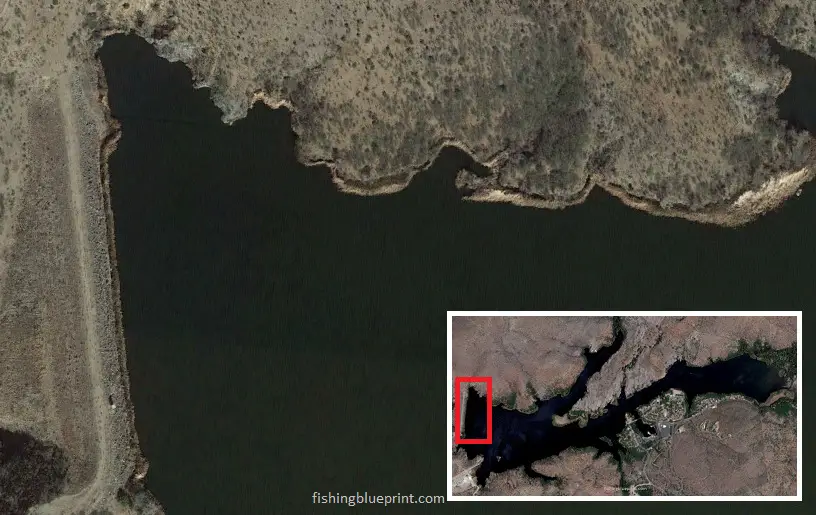
Fishing Patagonia dam gives you access to the lake’s deepest water which is important for a number of different reasons.
In the summer this area will commonly contain hold over rainbow trout from the previous winter’s stocking efforts.
Otherwise graph the entire dam looking for schools of shad with bass and crappie suspended over rocky shelves.
This section of the lake can get very windy. And even with the best trolling motor the wind can quickly blow you off your spot which will significantly decrease your chances of catching a fish..
That is why we strongly suggest buying a quality drift sock. For those who don’t know, a drift sock is like a parachute for the water. If it’s breezy to windy, you need to slow your drift otherwise your lure will not be in the strike zone long enough to catch a fish.
By the way, we found a really good quality drift sock made by Mythik Outdoors, and best of all they’re sold on Amazon.com. Go here to learn more about drift socks and read the reviews from actual customers.
Some of the effective baits for trout in this area include:
But wait! Before you tie on any bait nearly every professional fishing guide will strongly encourage the use of a fish attractor like a quality flasher or dodger 2-3 feet in front of any lure. This helps get the fish’s attention, kinda like ringing a dinner bell!
Trolling spoons such as a Krocodile spoon, Super Duper, Crippled Herring, Cast Champ, or Hus-Lure. Trolling spoons have an unpredictable, minnow-like motion that delivers bone-crushing strikes. Even the slowest current brings these lures to life. Add extra motion by twitching the rod tip and enabling the bait to pop and dart forward and flutter back.
Inline spinners such as the Bang-Tail and Shyster are non-twist spinners that boast an immediate spin blade design for incredibly rapid start-ups and the best slow retrieve performance.
Many anglers also place their confidence in the Blue Fox Classic Vibrax inline spinner. This little bait is a compact shallow running lure that performs best in 2 to 6 feet of water, depending on the speed of the retrieve or trolling speed. The patented two-part body emits low-frequency sound vibrations that attract fish. This lure is best used in lakes, rivers, and streams.
Minnow style baits also work very well either cast-and-retrieved or trolled. These perform best if the water is clear/slightly stained. The Luhr-Jensen Quick Fish and the Rapala BX minnow are constructed from hard plastic, have a wide wobble action, and are extremely durable. Whereas the Rapala Original Floating Minnow and the Ultra Light Minnow (all are slow sinking) both give you a tighter wobble perfect for clear water and pressured fishing conditions.
Better yet, just buy a complete done-for-you trout lure kit!
Now if you’re fishing from the shore, kayak, or even from the shore you should also consider using these additional baits:
- Real or artificial corn – great because it will never spoil or mold over
- Natural salmon eggs – it’s hard to beat natural salmon eggs when trout are eating salmon eggs, they’ll eat up jars of this stuff!
- Artificial salmon eggs – great because they float off the bottom – ideal in rocky or grassy conditions
- Real worms – such as meal worms or nightcrawlers
- Artificial worms – great for trolling and will never die)
- Dough bait – great because they stay on the hook really well, it floats if you put enough on the hook, comes in a variety of colors and scents.
- Wet flies (sinking flies) – Wet flies imitate insects that develop and inhabit below the water level before emerging and rising to the surface.
- Woolly bugger flies – One of the most popular fly patterns ever is the Woolly Bugger. These mimic small fish, leeches, larvae, and worms.
Steamer flies – These mimic larger animals found in streams, rivers, and lakes including crawfish, larger leeches, and smaller fish.
.
Oh, before I forget, did you know that there is an article about how to troll for salmon, trout, and kokanee the right way? Go here to find out more.
Effective baits for bass in this area include: topwater lures, buzzbaits, frog lures, crankbaits, soft plastic swimbaits, spinnerbaits, jerkbaits, chatterbaits, swim jigs, hair jigs, and underspin jigs when the bass are aggressive. Flutter spoons work great in the deeper shelves.
If the bass are timid, then drop shot, tubes, Ned rig, Neko rig, Mojo rig, Carolina rig, and football jigs all work really well.
Located: west end of the lake
Structural features: access to deep water, tuies along the shoreline, deep water drop offs and shelve
Best species to target: trout, bass, crappie, bluegill, catfish
Most effective way to fish this spot: boat, kayak, float tube
Ash Canyon
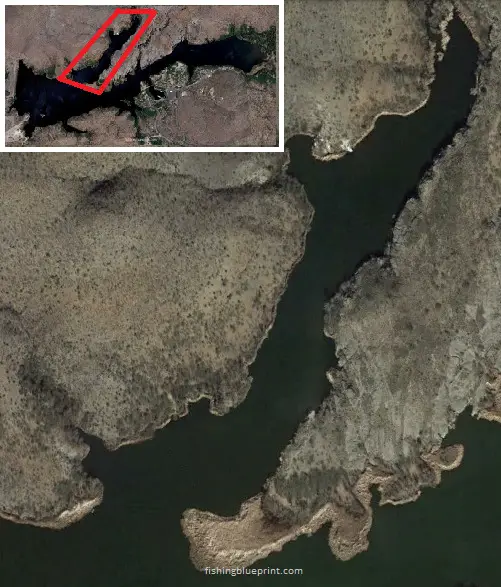
Look Closer…
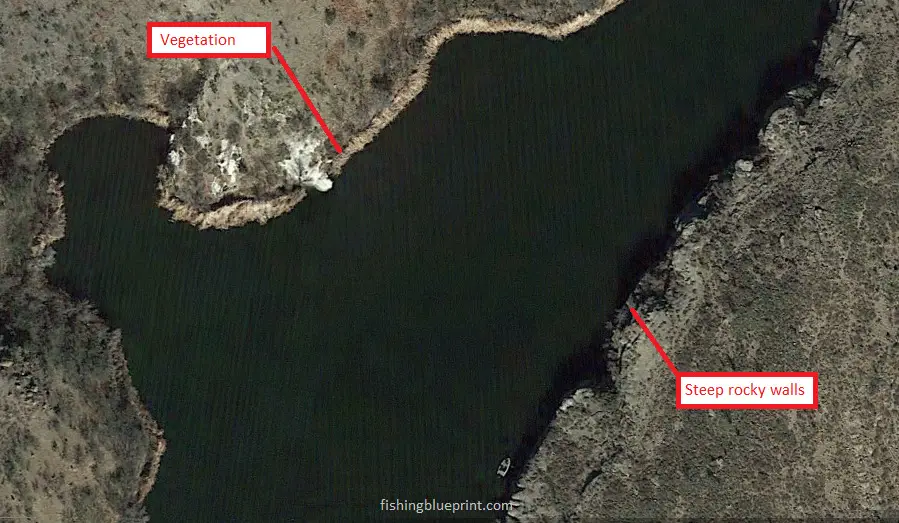
Ash Canyon is a long straight canyon that features a deep channel.
A really great feature about this fishing spot is the one main creek channel that runs down the middle of it, however there are several other cuts and ditches (smaller secondary creek channels) that run into it, kinda like a narrow leaf.
There are some slight channel swings that can hold fish in the fall and summer.
Scan the intersections for ledges, drop offs, boulders, rock piles, ridges associated with the two intersecting channels.
This area can be amazing after a storm and water is running into the lake from the back of the cove by targeting the ledges and cuts near the back of the cove.
During the summer, bass will hold in the tules growing along the shoreline and on the main lake points and ledges.
Effective baits for this area include: topwater lures, flutter spoons, buzzbaits, crankbaits, soft plastic swimbaits, spinnerbaits, chatterbaits, jerkbaits, swim jigs, hair jigs, and underspin jigs when the bass are aggressive.
For vertical emergent vegetation such as tall tulles/cattails or patches of thin twig-like reeds, you can use a frog lure, flipping lure, heavy vegetation punching bait. If it’s breezing and you’re fishing emergent vertical vegetation, consider switching to a spinnerbait, swim jig, or chatterbait.
Fish the weedline edges parallel with crankbaits, lipless crankbaits, spinnerbaits, frog lures, soft plastic swimbaits, umbrella rigs, swim jigs, underspin jigs or chatterbaits.
If the bass are timid, then drop shot, tubes, Ned rig, Neko rig, Mojo rig, Carolina rig and football jigs all work really well.
Located: northwest end of the lake
Structural features: access to deep water, tules along the shoreline, main lake deep water drop offs and shelve
Best species to target: trout, bass, crappie, bluegill, catfish
Most effective way to fish this spot: boat, kayak, float tube
Spillway Cove

This is a small open bay that has multiple smaller drainage ditches (all of whom are submerged) will dump into the main lake near the dam.
Although this bay is small, it has many different structures you can target and fish.
There is a small tule-lined island, rocky high spots, ridges, humps, and ledges.
Moving further into the bay, make sure to scan the ditch and channel interactions and fish the tules on the shoreline.
Will commonly attract late-season spawning bass in May and June.
Effective baits for this area include: topwater lures, buzzbaits, crankbaits, soft plastic swimbaits, spinnerbaits, jerkbaits, chatterbaits, swim jigs, hair jigs, and underspin jigs when the bass are aggressive. Flutter spoons work great in the deeper channel sections as well.
For vertical emergent vegetation such as tall tulles/cattails or patches of thin twig-like reeds, you can use a frog lure, flipping lure, heavy vegetation punching bait. If it’s breezing and you’re fishing emergent vertical vegetation, consider switching to a spinnerbait, swim jig, or chatterbait.
Fish the weedline edges parallel with crankbaits, lipless crankbaits, spinnerbaits, frog lures, soft plastic swimbaits, umbrella rigs, swim jigs, underspin jigs or chatterbaits.
If the bass are timid, then drop shot, tubes, Ned rig, Neko rig, Mojo rig, Carolina rig, and football jigs all work really well.
Located: southwest end of the lake
Structural features: access to deep water, small bay with ditches and other hard structures, tules along the shoreline, deep water nearby.
Best species to target: trout, bass, crappie, bluegill, catfish
Most effective way to fish this spot: boat, kayak, float tube
Hangman’s Cove
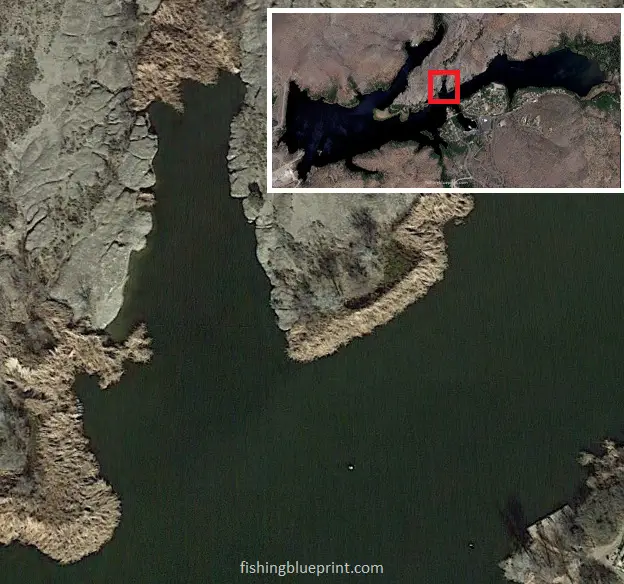
This is a small deep cove just off the main lake with several ditches that drain into it. There are also several drop offs and ledges which makes it unique.
This area can be amazing after a storm and water is running into the lake from the back of the cove by targeting the ledges and cuts near the back of the cove.
Effective baits for this area include: topwater lures, buzzbaits, crankbaits, soft plastic swimbaits, spinnerbaits, jerkbaits, chatterbaits, swim jigs, hair jigs, and underspin jigs when the bass are aggressive. Flutter spoons work great in the deeper channel sections as well.
If the bass are timid, then drop shot, tubes, Ned rig, Neko rig, Mojo rig, Carolina rig, and football jigs all work really well.
Located: mid-lake across from the marina
Structural features: Deep water cove off the main lake, drop offs, shelve, tules along the shoreline
Best species to target: trout, bass, crappie, bluegill, catfish
Most effective way to fish this spot: boat, kayak, float tube
Sonoita Creek Flats
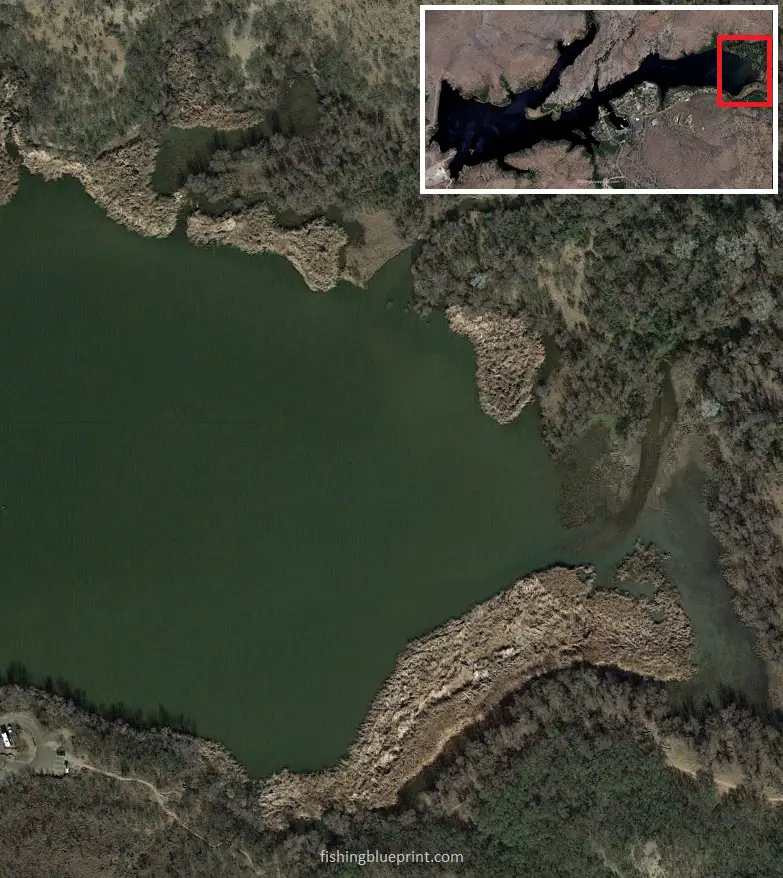
This spot is great because it’s a “vegetation flat” with important structure. It’s a fairly large area that has very little change in depth and is covered in vegetation. Sometimes this vegetation can grow to the surface creating a floating mat or canopy.
Tules line the edges and are phenomenal for flipping.
When the weeds are just developing or dying off, this huge flat fishes well, creating deep channels in the vegetation. Bass will hide in weed-filled holes and ambush bait.
It’s relatively shallow (between 3 and 10 feet deep) and what makes this spot unique is all the cover the fish can hide in and call home. Parts of the flat close to deep water, if the fish feel threatened, they can retreat to. Fishing the outside edges can frequently result in fish being caught.
Lastly, there are some spots within this area that will create large ‘holes’ in the weedbed. These open areas will frequently hold bass.
Grass/ reeds/ tulles: If the grass is submerged you fish over the tops with a topwater lure, buzzbaits, frog lure, chatterbaits, or whopper plopper.
For floating vegetation mats go with a frog lure, flipping lure, heavy vegetation punching bait, or a Texas rigged Senko.
For vertical emergent vegetation such as tall tulles/cattails or patches of thin twig-like reeds, you can use a frog lure, flipping lure, heavy vegetation punching bait. If it’s breezing and you’re fishing emergent vertical vegetation, consider switching to a spinnerbait, swim jig, or chatterbait.
Fish the weedline edges parallel with crankbaits, lipless crankbaits, spinnerbaits, frog lures, soft plastic swimbaits, umbrella rigs, swim jigs, underspin jigs or chatterbaits.
Located: east end of the lake
Structural features: vegetation flat
Best species to target: bass, crappie, catfish
Most effective way to fish this spot: boat, kayak, float tube
How To Catch Fish In Patagonia Lake?
Rainbow Trout
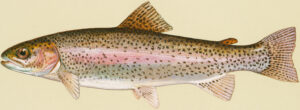 Arizona Game & Fish Department grow and stocks local lakes and reservoirs like this lake with Rainbow Trout.
Arizona Game & Fish Department grow and stocks local lakes and reservoirs like this lake with Rainbow Trout.
Due to this lake being relatively unpressured, deep, and colder, and most other desert reservoirs, the stocked trout do very well.
Since the trout are produced in local fisheries, they are healthy and have no limit on the amount of trout that can be consumed.
Typically trout are stocked twice a week, however, it can vary.
General Trout Details
Spawn: March-May
Food: insects and crustaceans.
Arizona State Record: 15 lb. 9.12 oz. 32.5 in., Willow Springs Lake Harold Wright, Sun City 9/29/06
Table Quality: Depending on the fishes diet, the meat can be white to orange-red in color. The meat is firm, flaky, and is considered excellent eating.
Angling techniques:
- Trolling with or without downriggers
- Trolling flies
- Worms
- Salmon eggs
- Powerbait
- Corn
- Cheese
- Marshmallows
- Spinners
- Spoons
- Flies
- *The number one key to successful trout fishing, is to use light line (2 to 6 pound) and small hooks (10-14 sizes), and small sinkers
Largemouth Bass
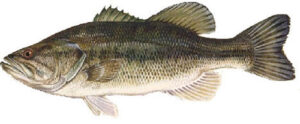 The Largemouth bass is a carnivorous member of the sunfish family. Most lakes hold the Northern strain species, however the Roosevelt chain lakes have been stocking the lakes with Florida strain species of largemouth bass.
The Largemouth bass is a carnivorous member of the sunfish family. Most lakes hold the Northern strain species, however the Roosevelt chain lakes have been stocking the lakes with Florida strain species of largemouth bass.
The Northern strain is thought to be considered more aggressive and offers a better fight than their Florida strain cousins. Whereas, the Florida strain can grow to an enormous size.
Listed below are a handful of facts, top spots, and best lures to use to help you out…
If you’re still not sure how to catch a bass, do worry. A complete section on Bass Fishing 101 was written to help you out. In that section, you’ll learn about the top ways to get you catching bass fast.
Read more: Beginner’s Guide To Bass Fishing Basics – Tips, Secrets & Things To Avoid
General Largemouth Bass Details
Spawn: Spring, March-May
Food: Shad, bluegill, crayfish
Arizona State Record: 16 lb. 7.68 oz. 28.0 in., Canyon Lake Randall E. White, Mesa 4/22/97
Table Quality: Decent. Firm white meat.
Angling techniques:
Black Crappie
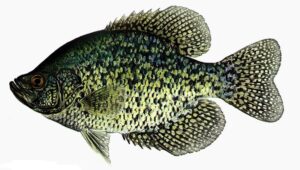 Introduced to Arizona in 1905, this lakes holds black crappie. These fish tend to linger over submerged brush and timber and are found in schools.
Introduced to Arizona in 1905, this lakes holds black crappie. These fish tend to linger over submerged brush and timber and are found in schools.
The black crappie are much more tolerant in cooler water than their white crappie cousins.
Black crappie can be described as having an irregular black dots and blotched on the back and have more of a “silvery-olive” background.
Average weight of a crappie in is going to be 0.75-pounds, however electro-netted samples show they can get over 3-pounds in size!
The best time to fish for crappie in this lake and other lakes similar to it is in summertime while you’re night using a submerged green light. If you don’t know what a green fishing light is, or if you’re unfamiliar, then click this link to learn more.
General Crappie Details
Spawn: April – mid-June
Food: Larvae, small fish, and crustaceans. Threadfin shad make up their main diet.
Arizona State Record: 4 lb. 10.0 oz. –in., San Carlos Lake John Shadrick, Mammoth 1959
Table Quality: The meat is excellent. It’s firm, flaky and white.
Angling techniques:
- Live minnows under bobbers
- Crappie jigs
- Crappie tubes
- Silver spoons
- Spinners
Catfish
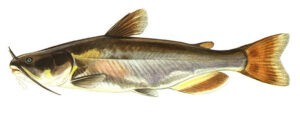
Channel catfish weight will range from 0.5-to-15-pounds in and of the Roosevelt chain lakes, including Canyon Lake. However, the average weight will be between 1-4-pounds.
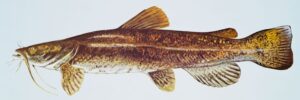
Conversely, “smaller” flathead catfish will weigh in at 15-pounds and can grow around 75-pounds. A flathead survey conducted in 2016 and 2020 caught a flathead that weighed over 48-pounds!
General Catfish Details
Spawn: March-June
Food: Carp, bluegill
Arizona State Record:
Channel catfish – 33 lb., 5.76 oz., 39.5 in., Upper Lake Mary Carson Pete, 3/26/17
Flathead catfish – 76 lb. 8.64 oz., 53.5 in., Bartlett Lake Eddie Wilcoxson, Surprise 04/13/13
Table Quality: Soft white meat. In the summer the meat will taste muddy.
Angling techniques:
Flathead catfish:
- live bait such as smaller carp, full sized bluegill, or tilapia
Channel catfish:
- chicken liver
- hotdogs
- stink bait
- small bluegill
- small carp
Bluegill/ Sunfish
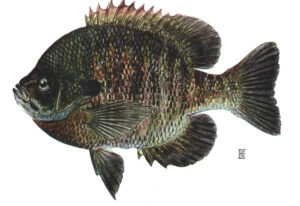 Introduced to Arizona in 1932, the bluegill has teal-blue coloring on the bottom portion of the chin and gill plate. It also has a solid black opercula flap just behind the gill plate.
Introduced to Arizona in 1932, the bluegill has teal-blue coloring on the bottom portion of the chin and gill plate. It also has a solid black opercula flap just behind the gill plate.
Bluegill are found on the shoreline and prefer nearby structures. Bluegill are incredibly aggressive and will quickly attack anything that looks like it could be eaten. Due to their aggressive behavior, they are one of the easiest fish to catch and are a great way to introduce someone to fishing.
Spawn: April and May
Food: Small fish and insects
Arizona State Record: 3 lb. 15.68 oz. 15.75 in., Goldwater Lake. Christopher Ray Mapes, Prescott Valley 5/2/04
Table Quality: Firm, white meat
Angling techniques:
- Worms
- Dough balls
- Slim jim sausages pieces on a small hook (not lying… it really works)
- Small spinners
- Trout flys
Carp
Carp are an oily freshwater species of fish and are native to Europe and Asia. Carp are considered invasive to the United States.
The big, hard fighting fish are really fun to catch. Many anglers will fish for carp at night and bowfishing from the shore or from a boat!
Carp can be consumed however, their muddy taste and boney meat make it one of the least desirable fish to eat.
Spawn: March-June
Food: algae, plant matter, fish eggs, insects, aquatic worms, small crustaceans (snails), and small crayfish
Arizona State Record: 37 lb. 0.0 oz. 40.0 in., Bartlett Lake Jonathan Gardner, Phoenix 8/8/87
Table Quality: Poor. Soft white flesh that is muddy and riddled with bones
Angling techniques:
- Dough balls
- Corn
- Worms
- Cherry tomatoes (not kidding)
- Commercial carp baits
Boat Ramp & Marina At Patagonia Lake
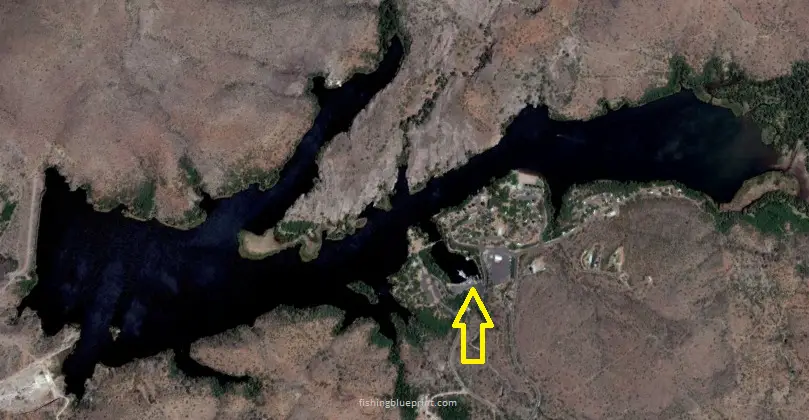
Look Closer…
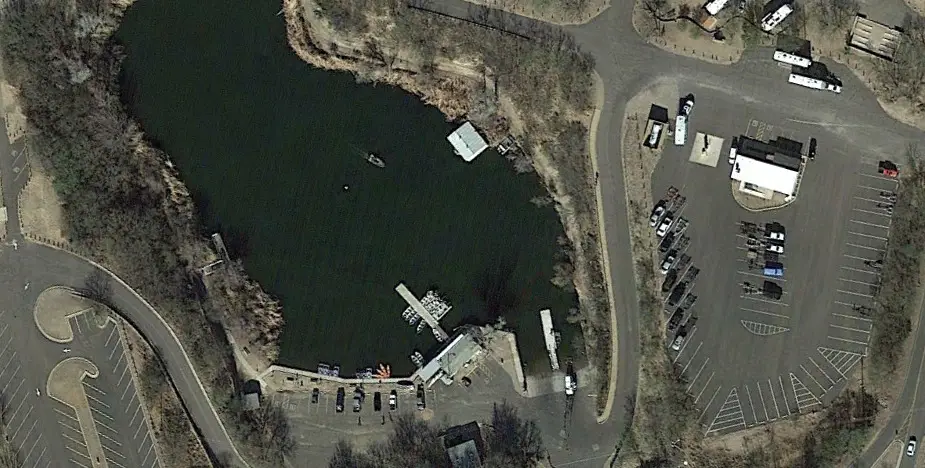
Patagonia Marina and Boat Ramp
Patagonia Lake Rd, Rio Rico, AZ 85648
(520) 287-2804
Lanes: 2
Groceries available: yes
Gas: yes
Bathrooms: yes
Showers: no
Electric: no
Camping nearby: yes
Top Tackle Shops Near Fool Hollow Lake
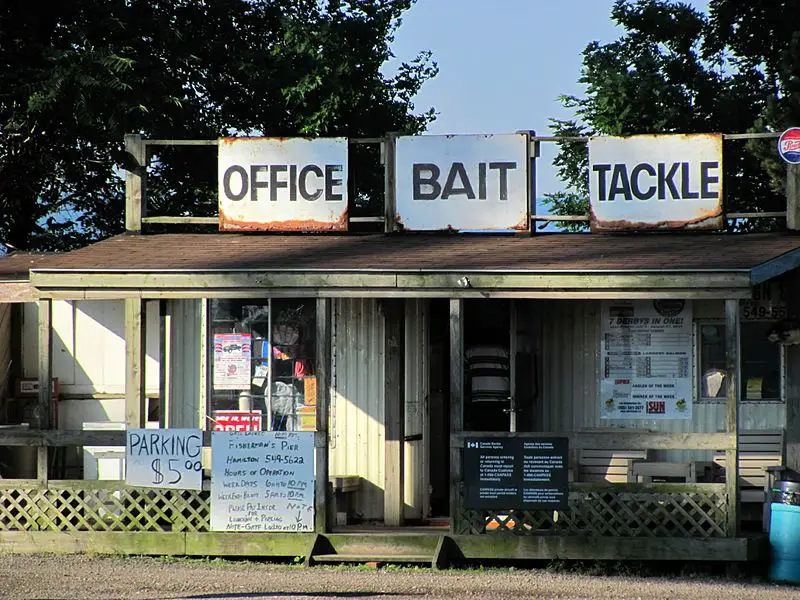
Patagonia Marina and Boat Ramp
Patagonia Lake Rd, Rio Rico, AZ 85648
(520) 287-2804
Lakeside Market
Patagonia Lake Rd, Rio Rico, AZ 85648
(520) 287-5545
Big 5 Sporting Goods
714 W Calle Arroyo Sur, Green Valley, AZ 85614
(520) 399-2102
Dry Creek Outfitters
5655 E River Rd, Tucson, AZ 85750
(520) 326-7847
Sportsman’s Warehouse
3945 W Costco Dr, Tucson, AZ 85741
(520) 877-4500
Places To Camp, Lodging And Rv Parks
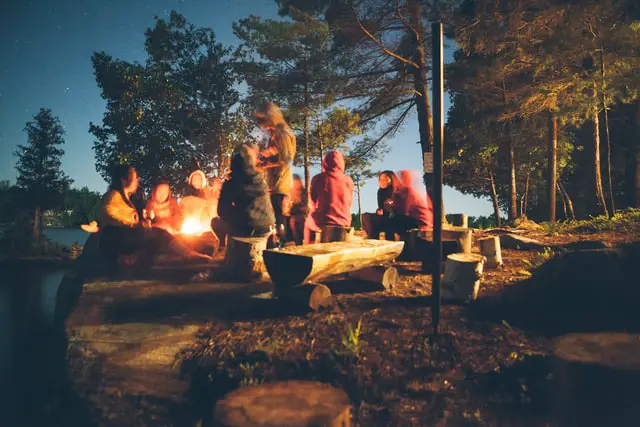
Patagonia Lake State Park
Campground host: On-site.
Quiet hours: 9 p.m. to 8 a.m. (running generators, loud music, or loud voices not permitted during quiet hours)
- Location: 400 Patagonia Lake Rd, Patagonia, AZ 85624
- Phone number: (520) 287-6965
- Nearby access to the lake: yes
- Tents, trailers, and small motorhomes are allowed.
- Site quantity: 105 sites
- Low season: October – March
- High season: April – September
- Concrete pads: yes
- Drinking water available: yes
- Toilets: yes
- Pets welcome: yes, but NO dogs allowed at beach day-use area.
- Fire ring: yes
- Picnic table: yes
- Nearby gas: yes
- Nearby place to buy firewood: yes
- Nearby place to buy groceries: yes
- Campground map – click here
- Reservations – click here
Other Activities You Can Do at Patagonia Lake
Fishing is not the only thing that brings people to the beautiful body of water. Here’s a list of other things you can do!
- Biking
- Bird watching
- Boating
- Skiing
- Kayaking
- Canoeing
- Sailing
- Swimming
- Camping
- Horseshoes
- Picnicking
- Hiking
- Gentle walking trails
- Nature photography trails
- Wildlife viewing
- Mountain biking
- Stargazing
- and most importantly… relaxing.
Other Arizona Related Fishing Articles
- Top 20 Best Places To Fish In Arizona 2023
- Interactive AZ Fishing Map 2023 – Where To Go Fishing In Arizona
- How much does a Arizona fishing license cost?
- Best Tackle Shops In Phoenix Arizona 2023
- Best Bass Fishing Lakes in Arizona 2023 (Voted by Local Anglers!)
- Alamo Lake Fishing Report 2024
- Apache Lake Fishing Report 2024
- Ashurst Lake Fishing Report 2024
- Bartlett Lake Fishing Report 2024
- Bear Canyon Lake Fishing Report 2024
- Big Lake Fishing Report 2024
- Blue Ridge Reservoir Fishing Report 2024
- Canyon Lake Fishing Report 2024
- Chevelon Lake Fishing Report 2024
- Kinnikinick Lake Fishing Report 2024
- Lake Havasu Fishing Report 2024
- Lake Mary Fishing Report 2024
- Lake Pleasant Fishing Report 2024
- Patagonia Lake Fishing Report 2024
- Rainbow Lake Fishing Report 2024
- Roosevelt Lake Fishing Report 2024
- Saguaro Lake Fishing Report 2024
- Show Low Lake Fishing Report 2024
- Sunrise Lake Fishing Report 2024
- Willow Springs Lake Fishing Report 2024
- Woods Canyon Lake Fishing Report 2024
More articles just for you...
Selecting Early Summer Bass Fishing Lures [Avoid 5 Common Mistakes]
A Complete Buyer’s Blueprint On The Best Early Summer Bass Lures On The Market Today! When it comes to bass fishing, choosing the right lure
Early Summer Bass Fishing [Avoid These 3 Sneaky Lies]
Learn these closely guarded secrets early summer bass fishing … and… dramatically boost your advantage over other anglers! Late spring to early summer bass fishing
Fear The Finesse? 7 Ned Rig Fishing Secrets Exposed!
Conquer the Fear of Finesse… and… Unlock the Potential Ned Rig Fishing – TODAY! Fellow Angler… Like most of you I’m pretty set in my
Fishing Spawning Bass [18+ Lures & Gear]
Get Ready For The Spawn Now When bed fishing, stealth is of the biggest essential tip. Instead of racing forward with a trolling motor, anglers
[2024 Editors Choice] Picking The Best Bass Fishing LINE For ANY Budget
What is the best bass fishing line? | What is a good fishing line for bass? The best type of bass fishing line is based
Drift Sock Basics – What It Is A Drift Sock & How To Use It [2024 Quick Start Guide]
What Does A Drift Sock Do? | Why Use A Drift Sock? photo cred: WLUK We’ve ALL been there… you work your butt off the

